Intel Broadwell Architecture Preview: A Glimpse into Core M
by Ryan Smith on August 11, 2014 12:01 PM ESTPutting It All Together: Low Power Core M
So far we’ve discussed Broadwell’s architecture on a broad basis, focusing on features and optimizations that are fundamental to the architecture. However to talk about the Broadwell architecture is not enough to fully explain the Core M itself. Though many of Core M’s improvements do come from Broadwell, Intel has also made a number of alterations to everything from the CPU packaging to the process node itself specifically for Core M. It’s the resulting combination of these factors that has allowed Intel to iterate on Broadwell-Y over Haswell-Y, and why Intel is so confident in Broadwell-Y’s capabilities and suitability for mobile form factors.
When it comes to building and configuring Core M, Intel likes to refer to their efforts as the “Fanless Challenge,” reflecting the fact that their biggest goal with Core M is to comfortably get the processor in to 10” tablets under 10mm in thickness that are passively cooled. A big part of getting into such a device is meeting the heat dissipation limitations of the form factor – a 10” tablet under 10mm would require a sub-5W SoC – which is where a lot of Intel’s engineering efforts have gone. Broadwell’s performance optimizations, the GPU optimizations, GPU duty cycling, and the 14nm process all contribute to getting a Core CPU’s power consumption down to that level.
But even that’s still not enough, and for Core M Intel went so far as to give Broadwell-Y its own die and design a low-power optimized version of their 14nm process just for it. This variant is designed to further reduce power consumption by optimizing the resulting transistors for lower power, lower voltage, lower clockspeed operation. By doing this Intel was able to further reduce power consumption in all of the major areas over what would be a traditional 14nm Intel process.
In the resulting 14nm Broadwell-Y process, voltage, capacitance, and leakage were all improved over the traditional 14nm process. Capacitance was reduced by 15%, minimum operating voltages by 10%, and leakage was improved to the point that it reduced SoC power consumption by 10%. The combination of all of these factors serves to significantly lower power consumption over what Intel’s traditional 14nm process would provide.
Working in concert with Broadwell-Y’s 14nm process, Intel has made a number of other changes to further reduce power consumption. Some of these are reflected in Broadwell’s overall design and others are unique to Broadwell-Y, such as using a lower TjMax for Broadwell-Y. By reducing the maximum operating temperature of the chip Intel has been able to realize further power savings by further reducing voltage and decreasing the maximum amount of temperature-dependent leakage the SoC will experience.
Meanwhile Broadwell-Y’s partner in crime, the on-package PCH, has received its own optimizations to reduce power consumption on the SoC’s total power consumption. The PCH itself is not much of a power hog in the first place – it’s still made on Intel’s 32nm process for this and cost reasons – but with such a strong focus on power consumption every watt ends up counting. As a result the Broadwell PCH-LP has seen optimizations that cut its idle power consumption by 25% and its active power consumption by 20%. Further improvements to the PCH’s monitoring hardware also mean it’s more responsive and can be controlled to a finer degree than the Haswell PCH-LP, and Intel has upgraded to a faster audio DSP to improve performance and reduce power consumption there as well.
Feeding all of that silicon in turn is Intel’s second generation Fully Integrated Voltage Regulator (FIVR), which further builds off of Intel’s other optimizations. The 2nd gen FIVR has been tuned for Broadwell-Y’s lower voltages, making the FIVR itself more efficient when delivering power at those voltages. To accomplish this Intel has implemented non-linear vDroop control, which is designed to better control the voltage when workload changes would cause voltage overshoots that waste power. And when even the 2nd gen FIVR isn’t efficient enough, this latest FIVR offers a second mode (LVR Mode) for low voltage/workload situations where the FIVR can be partially bypassed to reduce the FIVR’s power consumption.
Interestingly Broadwell-Y also sees the voltage regulation inductors redesigned and relocated in both the name of power efficiency and space efficiency. We’ll get to the case of space efficiency in a moment, but for power efficiency the new 3D inductors (3DLs) have been placed on the underside of the package, allowing the use of more efficient inductors that waste less power.
This brings us to the final element of Intel’s power optimization efforts, which involve further adjustments to turbo boost as part of Intel’s “hurry up and go to sleep” motto. New for Broadwell-Y is a 3rd power state, PL3, which allows for even greater turbo boosting, but for only a very limited period of time – on the order of milliseconds. PL3 represents the maximum amount of power the device battery can deliver, and while it’s okay to reach this value sparingly, PL3 is a fast drain that is very hard on the battery. The existence of PL3 in this case is as much for battery protection as it is for performance; it allows devices to tap into PL3 power levels on occasion, all the while allowing PL2 (the regular burst limit) to be defined at a safer value below the battery’s limit. Put another way, by knowing PL3 devices know how to stay farther away from it, which in the long run is what’s best for battery reliability.


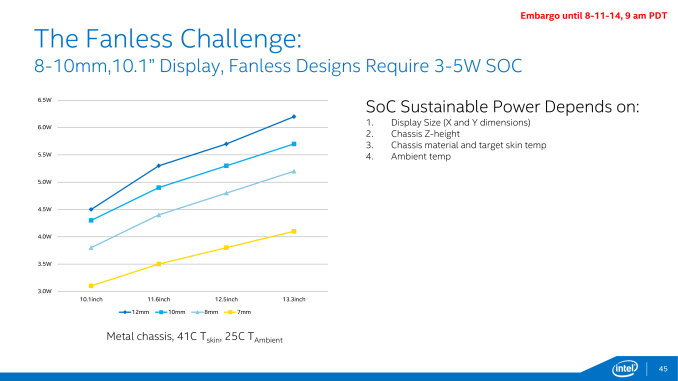
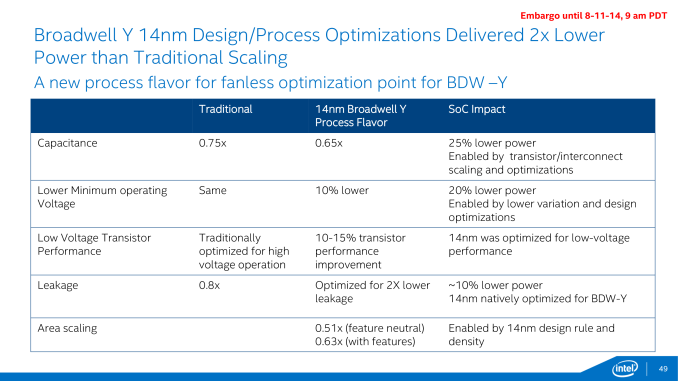
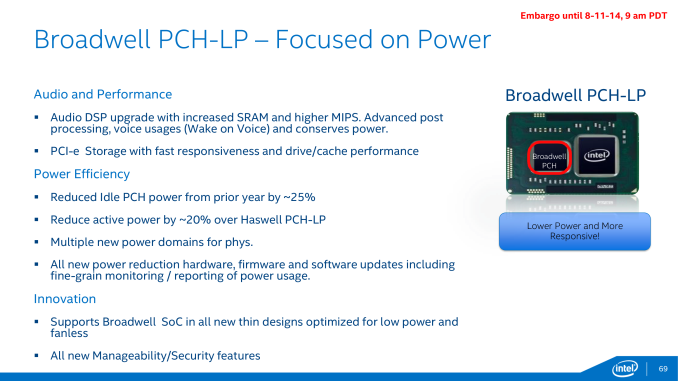
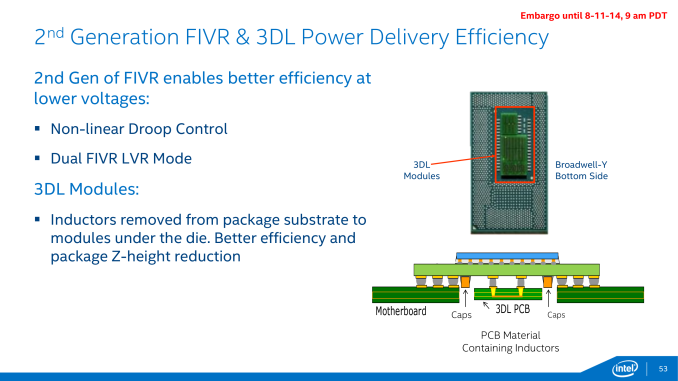

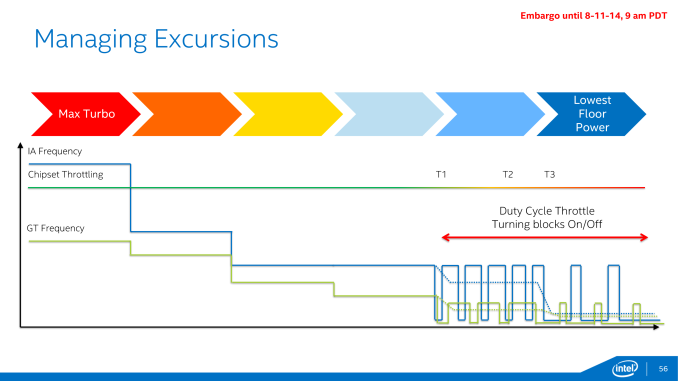








158 Comments
View All Comments
IntelUser2000 - Wednesday, August 13, 2014 - link
Broadwell Y's CPU portion is on 14nm but the PCH is on 32nm.Not to mention that Intel's 22nm process isn't that small compared to Foundries 28nm. 28nm Foundry is ~30% larger than Intel 22nm not 100%.
20nm Foundry is really a half node jump from 28nm considering density improves but performance much less. 16nm is another half node since density barely changes but perf improves.
Really, it can only be judged as a product.
mkozakewich - Thursday, August 14, 2014 - link
The 'myth' was that x86 was a horrible power-sucking pig. It was shown that it was possible to at least get close to ARM processors.Meanwhile, Intel's chips are NOT as low-performance as Apple's. The chip in Surface Pro 3 is about 2x-3x faster, and these should be about the same. With this year's Apple chip, imagine it to be 2x faster or so. Meanwhile, they'll probably both take the same amount of power. SoCs these days are running multiples of Watts. Even Intel Atoms used to take over 10, but now a full Intel Core computer can run under 6 Watts. It would be really interesting to run all these numbers and give a complete report on the state of mobile vs. notebook processing. They seem matched on power usage, but ARM chips are far cheaper and run at far less performance.
peevee - Monday, August 11, 2014 - link
Finally, a long awaited fanless design. I don't care about thickness that much as about energy waste on the heat and the fan to dissipate the heat.But... I have 2008 MacBook Pro with 2.4GHz Pentium M. If they achieved fanless design by bringing frequency down to, say, 1.8GHz, I am not interested (given that IPCs are not that different for real world applications). For me to upgrade, I want it to reach 3GHz, even if for a second and in a single thread, when starting applications for example. Anything below that is not a noticeable upgrade, and below 2.2GHz or so will be downgrade in practice.
And biggest problem of Intel is not how thick they processors are, it is Microsoft - with Windows 8 (and 8.1) being so unbelievably awful (yes, I do own it for a while). Krzanich should call Nadella immediately and tell him to fire Larson-Green, or they both are going down.
MikhailT - Monday, August 11, 2014 - link
You do realize this is for tablets and low power laptops (Chromebook/netbook style) only, right?It's not coming to MBP for any time soon unless you're talking about something else entirely, like the MBA, which also is not going to get M either because it'll be too big of a regression on the performance.
I don't think we'll see any Macs with Core M.
ZeDestructor - Monday, August 11, 2014 - link
You forget about IPC. Last I checked, compared to a Core 2 CPU at equal clock speeds, a Sandy Bridge CPU is 50+% faster on average, and Haswell is a further 15+% faster on top of that, all the while using less power.Krysto - Tuesday, August 12, 2014 - link
Since this is the FIRST core to be "fanless", they're probably squeezing a lot of stuff to make that work, and it probably still overheats. I wouldn't be too excited about it until we see how it does in actual devices, both from a power consumption point of view, but also a performance one (because if performance didn't matter, then we'd all just use ARM chips, no?).It would be laughable if Denver, which already beats mainstream Haswell Celeron, would be in range of Broadwell Y in performance, but still more energy efficient and with much better GPU performance.
UNCjigga - Monday, August 11, 2014 - link
Time to spin up the 12" iPad Pro rumor mill again...but would Apple really need to build a device that runs 64bit iOS *and* OS X?ilt24 - Monday, August 11, 2014 - link
Apple doesn't seem all that interested in adding touch screen capabilities to OSX.isa - Monday, August 11, 2014 - link
OK, I'm confused, so any help appreciated. I want to replace my old desktop replacement laptop with a Broadwell equivalent. For example, the Broadwell version of an HP Envy 17t. What flavor of Broadwell am I waiting for? The Y flavor? U? H? Something else? thanks.mapesdhs - Monday, August 11, 2014 - link
I would ask the opposite: why do you need a replacement at all? What is it your current
device cannot do, or does poorly? Once the newer products are out, find out which one
solves those issues at the lowest cost. This focus on the jargon side of computing tech
is the absolute worst aspect of how consumer computing has evolved since the 1980s.
Ian.